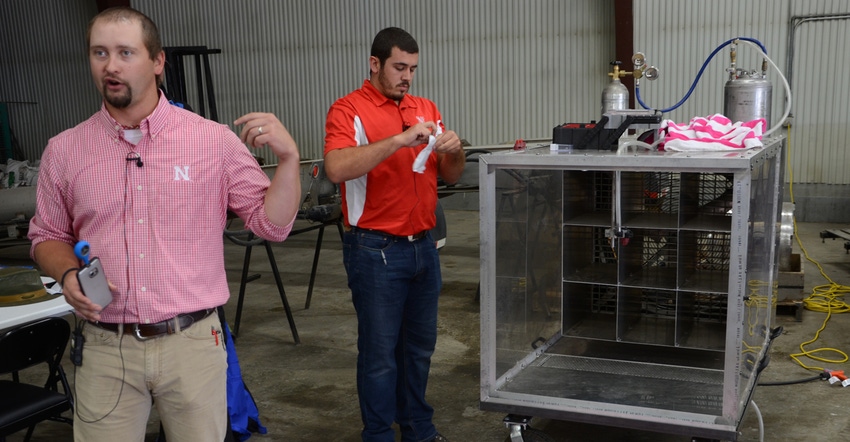
Spray drift is a hot topic these days, as farmers engage new tools in their constant battle to beat back herbicide-resistant weeds. Understanding the building blocks of spray drift can help you take action to avoid problems during application time. Understanding these four factors that play into drift can help you better manage your spraying in the future.
Thomas Butts, a graduate student who works with Greg Kruger, an associate professor in the Department of Agronomy and Horticulture at the University of Nebraska-Lincoln, is involved with that school's Pesticide Application Technology Mobile Training Lab. UNL also has the only U.S. EPA-approved wind-tunnel in the United States for testing drift and drift mitigation strategies.
During a recent conference sponsored by West Central Distribution, Butts walked through the factors that make up drift. West Central's conference was called LIFT (Leaders of In-Furrow and Foliar Technologies).
In summary, the four factors are wind speed, boom height, distance to susceptible vegetation and spray particle size.
One issue Butts brought up during his talk — and one farmers should be aware of when considering spray issues — is the idea of properly engaging your spraying. "There was a case where a farmer had an issue of drift and was brought into court," Butts said. "The opposing lawyer subpoenaed the farmer's spray log for the day in question, and the farmer said the wind speed was about 5 to 8 miles per hour with gusts up to 10, light and variable."
The airport, for the same day, was reporting 20-mile-per-hour winds and gusts above that, Butts said. "There could be different conditions at the farm than the airport, but the lawyer then pulled the rest of the farmer's logs," Butts said. Turns out every log entry from the farmer on the day of spraying was "winds 5 to 8 up to 10 mph, light and variable." And this was no matter the conditions.
"We have to be honest, and we need to log actual conditions during spraying," Butts said
1. Wind speed. Wind speed and wind direction are the No. 1 factor to influence drift, over and above everything else. He noted that when the wind speed doubles, there is a 700% increase in drift when readings are taking 90 feet downwind from the sprayer. This is a key reason why spraying is only recommended when speeds are at 10 mph or lower.
He advises farmers to use a wind meter and noted that there are meters that can be hooked to your smartphone. The meters will measure wind speed and direction, and log that information into your phone with a GPS reference.
"And make sure you are recording wind speed at your boom height," he added.
2. Boom height. You might think that boom height would only influence drift in small ways. But if you raise your boom from 18 inches to 36 inches, you increase the amount of drift by 350% at 90 feet downwind.
Butts explained that boom height is based on your nozzles, so 80-degree nozzles with a 20-inch overlap would be 30 inches above the crop. For the 110-degree nozzles, you would run at 20 inches above the crop. That wider nozzle allows you to get closer to the crop, which can help reduce drift.
3. Distance from the susceptible crop. Drift isn't a concern in the target crop. But for off-target movement, knowing where the susceptible crops are is important, Butts said. "I know farmers cringe when they hear buffer zones," Butts said. "But this is going to be on more and more label registrations in the future."
He noted that knowing your surroundings and being aware of conditions are important. He shared the story of a scout who cleared a field for spraying, but when the applicator arrived and started spraying an insecticide, he found beehives. Those had been brought in after the scout had checked the field. "Knowing the surroundings is important," Butts said.
4. Spray particle size. Butts noted that there's really little you can do for the first three issues: you can't control the wind, you are limited on boom height changes and those susceptible areas aren't moving.
However, you can manage spray particle size, and he offered a demonstration using a portable wind tunnel that showed how spray drifts when particle size is too small.
The number to watch is DV50, which is the droplet size for 50% of the cumulative volume sprayed. Larger droplet sizes mean less drift, and there is concern that the smaller half of the DV50 would be too small and cause drift. However, there is a concern that larger droplet sizes might not provide adequate coverage and control.
The challenge is spray fines less than 200 microns. But cutting pressure doesn’t make a big enough difference; you'll need to change nozzles, Butts said.
He demonstrated several steps for reducing particle size, using the TeeJet TTI air induction nozzle to bring fines below 3% of what is sprayed. There are other air-induction nozzles on the market, and more are being approved each week for the newest crop protection products on the market.
Managing spray nozzle size is a key part of keeping drift under control. Watching wind speed, boom height and proximity to susceptible crops will help keep costly drift issues under control.
About the Author(s)
You May Also Like




